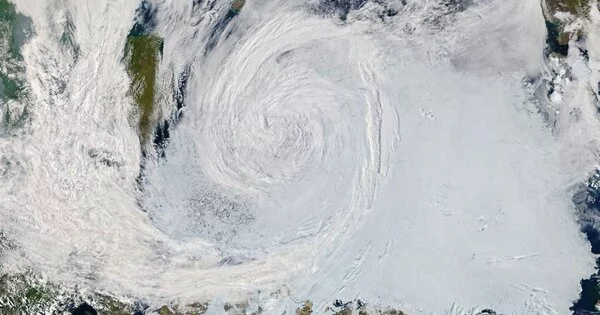Arctic cyclones, also known as polar low-pressure systems, are low-pressure areas that form over the Arctic Ocean and can bring strong winds, heavy snowfall, and low temperatures to the region. These storms can disrupt sea ice and contribute to its melting.
In 2012, an Arctic cyclone that formed over the Beaufort Sea off the coast of Alaska was the strongest on record, with wind speeds reaching up to 100 mph. This storm led to a surprising loss of sea ice in the region, with some estimates suggesting that it may have caused the melting of as much as 100 square kilometers of sea ice in just a few days. The loss of sea ice can have significant impacts on the Arctic ecosystem, as well as on global climate patterns.
In January 2022, the strongest Arctic cyclone ever observed struck. According to a new analysis, while forecasts accurately predicted the massive storm, models significantly underestimated its effect on sea ice. The findings indicate areas where forecast models for the changing Arctic Ocean could be improved.
A warming climate is causing a decline in Arctic sea ice, which has significant ecological, economic, and climate implications. In addition to the long-term shift caused by climate change, weather events affect sea ice from week to week.
It was a monster storm, and the sea ice got pummeled. And the sea ice models didn’t predict that loss, which suggests there are ways we could improve the model physics.
Melinda Webster
The strongest Arctic cyclone ever observed poleward of 70 degrees north latitude struck northeast of Greenland in January 2022. According to a new study led by the University of Washington, while weather forecasts correctly predicted the storm, ice models significantly underestimated its impact on the region’s sea ice. According to the study, which was published in the Journal of Geophysical Research-Atmospheres, existing models underestimate the impact of large waves on ice floes in the Arctic Ocean.
“The loss of sea ice in six days was the biggest change we could find in the historical observations since 1979, and the area of ice lost was 30% greater than the previous record,” said lead author Ed Blanchard-Wrigglesworth, a research assistant professor of atmospheric sciences at the UW. “The ice models did predict some loss, but only about half of what we saw in the real world.”
Accurate sea ice forecasts are important safety tools for Northern communities, mariners, and others operating in Arctic waters. The accuracy of forecasts in the Arctic Ocean also has broader effects. “The skill of a weather forecast in the Arctic affects the skill of weather forecasts in other places,” Blanchard-Wrigglesworth said.

The January 2022 cyclone had the lowest estimated pressure center above 70 degrees north since satellite records began in 1979. It was a ferocious rendition of a typical winter storm. Climate change does not appear to be to blame for the cyclone: the researchers found no trend in the strength of intense Arctic cyclones since 1979, and sea ice area was close to the region’s historical average before the storm hit.
Record winds howled over the Arctic Ocean during the storm. In open water, the waves reached 8 meters (26 feet) in height and remained surprisingly powerful as they moved through the sea ice. The ice heaved 2 meters (6 feet) up and down near the pack’s edge, and NASA’s ICESat-2 satellite recorded waves reaching as far as 100 kilometers (60 miles) toward the pack’s center.
Six days after the storm, the sea ice in the affected waters north of Norway and Russia had thinned significantly, with some areas losing more than half a meter (about 1.5 feet) of thickness.
“It was a monster storm, and the sea ice got pummeled. And the sea ice models didn’t predict that loss, which suggests there are ways we could improve the model physics,” said second author Melinda Webster, a research assistant professor at the University of Alaska Fairbanks. She begins a research position in the new year at the UW Applied Physics Laboratory.
The new analysis shows that the storm’s atmospheric heat had only a minor impact, implying that another mechanism was to blame for the ice loss. Blanchard-Wrigglesworth suggests that the storm’s waves broke up ice floes more forcefully than models predicted as they penetrated deep into the ice pack; or that waves churned up deeper, warmer water and brought it into contact with the sea ice, melting the ice from below.
Despite an accurate storm forecast, the unexpected ice loss suggests that models could be improved in this area. The researchers hope to monitor future storms to pinpoint exactly what led to the dramatic sea ice loss, potentially by placing sensors in the path of a future approaching storm.
While this storm does not appear to be linked to climate change, the increasing amount of open water as sea ice melts allows for larger waves that are eroding Arctic coastlines. These waves, according to researchers, may also have an impact on the remaining sea ice pack.
“In the future, keep in mind that these extreme events may result in these episodes of massive sea ice loss,” Blanchard-Wrigglesworth said.
















